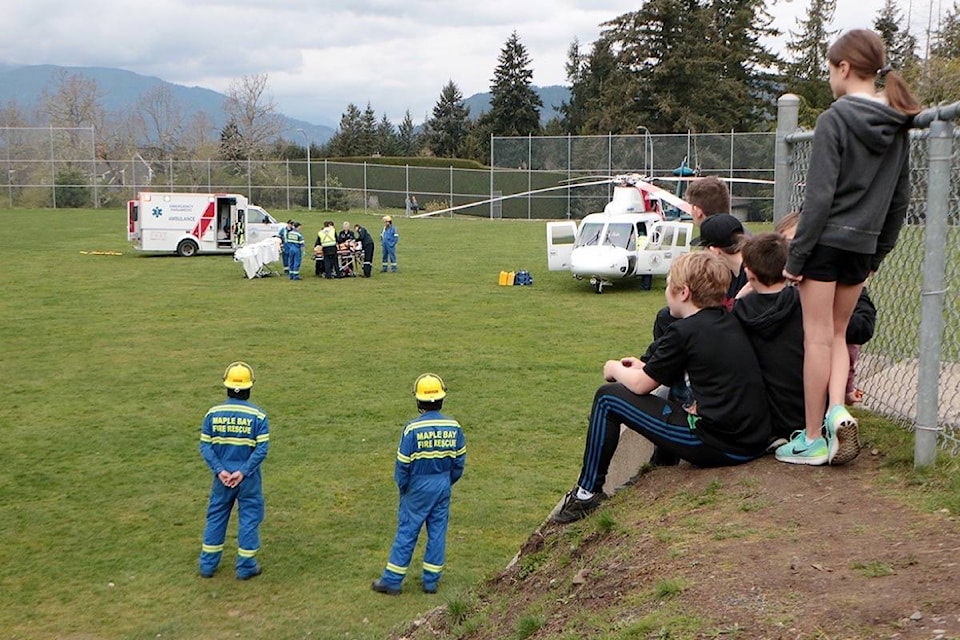An ambulance air crew was dispatched to Maple Bay Tuesday afternoon to transport a victim of a potential drowning to hospital.
At just after 4 p.m. on Aug. 4, BC Emergency Health Services received a call requesting assistance at a residence in the 1600 block of Grant Road, located near Quamichan Lake.
One ground and one air ambulance crew were dispatched to the scene.
Firefighters from the Maple Bay fire hall also assisted ambulance workers on site, and cleared an area at Maple Bay Elementary School for the helicopter to land.
The patient was transported by air ambulance helicopter in serious condition to a hospital outside of the Cowichan Valley.
“Due to privacy legislation, we are not able to give out patient information, including confirming gender, age or details of an injury,” said a press release from BC Emergency Health Services.
“Once our paramedics have transported to hospital, we don’t have information on a patient’s status.”
RELATED STORY: WITH 18 DROWNING DEATHS IN B.C. THIS YEAR, ADVOCATES URGE CAUTION DURING SUMMER
It’s a fact that more than 400 Canadians die in preventable water-related incidents every year.
As British Columbians look to summer “staycations” and many head to local lakes, rivers and ocean, safety advocates are urging for caution as drowning risks spike between May to September.
With 18 drowning deaths in B.C. so far this year, it is important to be “prepared ahead of time,” said Dale Miller, executive director of Lifesaving Society’s B.C. and Yukon branch.
Out of these drownings, four deaths have been recorded on Vancouver Island, and the Okanagan area has seen the highest number of cases with more than five deaths.
Most drowning deaths are preventable with proper knowledge of environment and safety measures.
“Don’t jump into water right way,” said Miller.
His advice is to check the characteristics of the water first — whether it’s fast running or cold — then look for drop-offs and rocks, and also be prepared for any emergency.
“If someone were to get into trouble, people need to know what to do,” Miller said.
“The majority of those who drown are within three to five metres of safety.”
People should have something to reach out or throw to a swimmer if they get into trouble.
It’s also important to stay sober, bring a swimming buddy along and wear a lifejacket.
If people are headed for swimming activities in remote areas, which are less accessible by emergencies and Search and Rescue, “personal responsibility and self rescue needs to be top priority,” said Miller.
RELATED STORY: 32-YEAR-OLD WOMAN DROWNS AT MATHESON LAKE IN METCHOSIN
July 19-25 was National Drowning Prevention Week in Canada, and the highest number of drownings usually occur around this time of year.
In the two weeks prior to NDPW, there were four recorded drownings in B.C.
Although drowning death numbers in B.C. have dropped in 2019 and 2020, Miller said the goal is to come down to zero.
In 2018, there were 44 drownings in B.C.
Based on Lifesaving Society’s statistics, swimming is the most common activity linked to drowning, followed by power boating.
In B.C., young adults between the age of 20-34 are at the highest risk of drowning, of which 80 per cent are males who are prone to overstep their limits and take risks for an adrenaline rush.
“Risk-taking contributes highly to drownings,” said Miller.
“When you get into trouble in water it’s very difficult to get out of it.”
With files from Black Press
robert.barron@cowichanvalleycitizen.com
Like us on Facebook and follow us on Twitter
